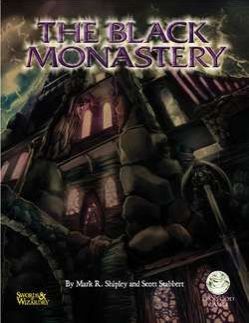The Black Monastery
 |
he Black Monastery is an adventure in the classic style because it follows the design assumptions that were common in many publications and local campaigns during the early days of Dungeons and Dragons. In the classic era¸ the dungeon master was the final authority and was assumed to have complete control. Every event did not have to have a complete rationalization¸ formula or rules explanation. Mysterious phenomena¸ riddles and surprises were the norm. This module assumes that the dungeon master will take control and mold it to his campaign.
In a classic game¸ monsters might be stronger or weaker without having to figure out why. For unknown reasons¸ Flinds were the only creatures capable of wielding nunchaku. Qullan would die before revealing the special techniques for sharpening their broadswords. Piercers would wait most of their lives just to drop on adventurers and spend the next month crawling back up the wall after a miss. Skeletons always did 1d6 damage no matter what weapons they wielded. Rust monsters made sense. Orcs and gnolls would live next door to each other in dungeons that were essentially monster hotels and no one worried about why. In one of the classic modules by Judges Guild a single giant rat in a group of two dozen had 26 hit points because a typist made a mistake and that was okay ‐ one of the rats was just really big.
Classic play usually assumed that monsters and player characters would follow standard archetypes. Magic-users always had white beards and pointy hats. Barbarians always wore rags and enormous fur boots. Paladins were noble and saintly. Fighters wore plate mail. Thieves climbed walls...a lot. Clerics were vaguely like Catholic priests gone bad¸ and they always chanted in Latin. All dwarves acted just like Gimli. All elves acted just like Legolas. Monsters were generally cheerful about their roles¸ including Norse berserkers who rated their own listing in the AD&D Monster Manual because they wandered around underground quite a bit¸ looking for player characters to fight.
In The Black Monastery¸ evil priests have left behind a large number of magical items and effects. They left poems and messages for intruders. They posted guardians that parade around chanting. They spawned ghostly effects that cannot be explained. Pictures are still hanging on walls. Dishes are rattling in the kitchen. Kobolds have decided a dungeon is a good place to roast a pig. Magic globes float in the air¸ waiting to explode. Statues perform strange¸ magical acts for no particular reason. Why? Who knows? All of that is okay. Explanations of these magical and monstrous events are provided from time to time¸ but they don't really matter. The point is to have fun running about looting the place and trying to survive.
The Legend of the Black Monastery
Two centuries have passed since the terrible events associated with the hideous cult known as the Black Brotherhood. Only scholars and story-tellers remember now how the kingdom was nearly laid to waste and the Black Monastery rose to grandeur and fell into haunted ruins.
The Brothers first appeared as an order of benevolent priests and humble monks in black robes who followed a creed of kindness to the poor and service to the kingdom. Their rules called for humility and self denial. Other religious orders had no quarrel with their theology or their behavior. Their ranks grew as many commoners and nobles were drawn to the order by its good reputation.
The first headquarters for the order was a campsite¸ located in a forest near the edge of the realm. The Brothers said that their poverty and dedication to service allowed them no resources for more grand accommodations. Members of the Black Brotherhood built chapels in caves or constructed small temples on common land near villages. They said that these rustic shrines allowed them to be near the people they served. Services held by